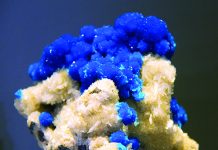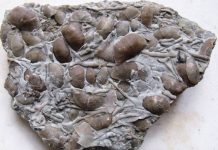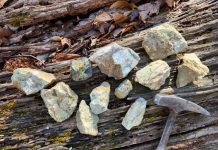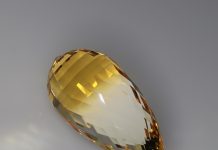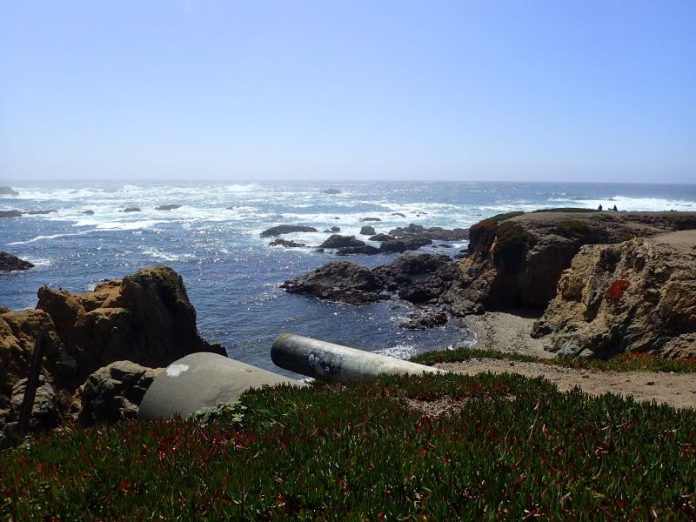
Glass Beach is west of Fort Bragg on northern California’s Mendocino Coast. Glass Beach is named for the abundant colorful sea glass found on the beaches in and near the south end of MacKerricher State Park. Sea glass is glass that was disposed of as trash and reworked and polished on saltwater beaches.
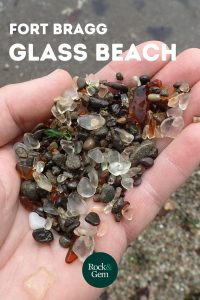
Sea Glass
Sea glass is often found near former shoreline and offshore garbage dumps along a saltwater coastline. The amount of glass disposed of may be limited, washed away, or stay on the ocean bottom. Sea glass is not freshly broken glass but is weathered glass that has gone through the process of tumbling in the sand and pebbles on the shoreline. As the waves come in and out, the glass is rolled among hard pebbles and rocks that chip away and pit the glass. Over time the glass takes on a frosty appearance and the sharp edges become rounded. This tumbling and polishing process can take 20 to 40 years to produce a frosted surface on the glass. In geologic time, this is not even the blink of an eye, but it is enough time to produce sea glass.
Sea glass is found in saltwater, but broken glass also washes ashore in fresh or brackish water beaches. Tumbled glass found on freshwater beaches is known as beach glass. Beach glass, since it is tumbled in fresh water, is not subject to the higher pH and dissolved ions found in saltwater. Beach glass is generally not as frosty or pitted as sea glass.
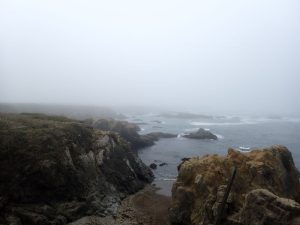
Fort Bragg
Fort Bragg was never a fort but a military garrison, and the garrison is long gone. The city is along the Shoreline Highway, also known as Highway 1, in Mendocino County. Fort Bragg is about 170 miles north of San Francisco.
The garrison at Fort Bragg was founded in 1857 and abandoned in 1867. In the late 1800s, Fort Bragg became a lumber town. The 1906 earthquake, which destroyed much of San Francisco, also destroyed much of Fort Bragg. The town was quickly rebuilt, but after World War II the lumber industry declined, and the last mill closed in 2002. The current Fort Bragg economy is largely based on tourism and services.
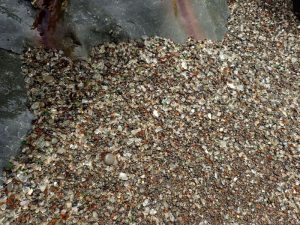
Origin of Fort Bragg Beach Glass
The history of waste disposal at Fort Bragg explains why Glass Beach exists. All cities must get rid of their garbage, and before environmental regulations existed, it was common to dump garbage at the town dump. The town dump was often literally a dump or a series of dumps and nothing like modern-day trash disposal.
During the later part of the 1800s and the beginning of the 20th century, most trash was simply disposed of in backyard pits and privies, but this was unsustainable as the town grew. The 1906 earthquake destroyed much of the center of Fort Bragg, and the demolition debris had to go somewhere. The city bulldozed the debris and pushed it over the cliffs at a dump site west of the middle of the town, and this became the town dump. At most seaside towns, the ocean would typically swallow the waste and it would disappear. However, the ocean currents and coastline kept the debris near the shore. By 1943, the site was too full for continued dumping, despite burning to reduce the volume. The city then started dumping the trash at a new seaside site about a quarter of a mile north on the coast. This filled up by 1949. They then dumped at another nearby site to the north from 1949 to 1967. In 1967 the city managers closed all the sites to further dumping. A long cleanup process began, with much of the larger debris removed, but the broken bottles, plates, and glass, which were now part of the beach, remained.
The 1906 to 1943 dumping site is known as “Glass Beach 1” and the 1943 to 1949 site is known as “Glass Beach 2.” California State Parks acquired the 1949 to 1967 location, known as “Glass Beach 3,” in 2002 and this area is now within MacKerricher State Park. Sites 1 and 2 are outside of the State Park and are next to City Park property.
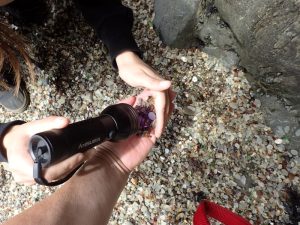
Visiting Glass Beach
My daughter and I visited Fort Bragg and Glass Beach in July 2022. We drove from Sacramento and crossed the Northern Coast Range by Highway 20. This is a scenic drive, but the road over these mountains is steep with sharp curves and took much longer than expected. Be sure you have a full tank of gas.
We reached Fort Bragg late in the morning. It was still quite foggy, despite it being mid-summer. We were not sure where to go, but “Glass Beach” is labeled on Google Maps, so we started here. We parked at the local parking area for the beach, and it was getting full of cars. The parking area also had a restroom, which was a good sign and an indicator of a well-managed park. We walked on a short trail and were soon on the beach.
I knew at once we were in the right place, as the beach seemed to be almost all glass. The glass was clear, white, yellow, orange and green, with occasional red, blue and purple. The sizes ranged from less than .75 inches to over one inch, with most less than half an inch. The pieces were rounded, and I did not see any sharp or broken edges. It was easy to see how the surf tumbled and polished the glass. While the beach pebbles have been polished for millennia, the beach glass had only been polished for several decades, but it was still as worn down as the nearby pebbles of various igneous and metamorphic rocks.
As this was part of the State Park, we could not collect any glass. My daughter fortunately had brought her ultraviolet (UV) flashlight. She said that some of the glass at Glass Beach was uranium glass – glass infused with uranium. This glass fluoresces light green under UV light.
We were in broad daylight, and the sun started to come out, so it was difficult to see which glass had uranium. We were able to make a dark area with our hands, and sure enough, we quickly found fluorescent uranium glass.
Since we did not know much about the other sites in the area, our beach visit was limited to what I later learned was Site 3, which was the dumping site from 1949 to 1967. This site had a tremendous amount of beach glass, and the outcrops along the cliffs were a mass of lithified sediments that were packed with compacted debris. The debris included plate glass, ceramic and porcelain plates, wire, nails, wood, metal, spark plugs, and just about everything else expected in town trash.
We soon left Site 3 to go into town for lunch. Afterward, we went to the Sea Glass Museum, which is at 303 North Main Street, Suite F, in downtown Fort Bragg. We drove to the museum and did not have any trouble finding parking.
The Sea Glass Museum is well worth a visit to learn about sea glass and the local history of Fort Bragg. The museum has displays of sea glass and includes displays under UV light. The displays discuss sea glass and the various types in detail.
The museum has a large display of uranium glass, which is also known as Vaseline glass. Vaseline glass got its name as the color in normal light resembles Vaseline petroleum jelly. Uranium dioxide was added to the glass during manufacturing to give it a yellow tint and to make it fluorescent. The glass was popular from the mid-1800s to the early 1900s. In 1943, the supply of uranium oxide for glass was cut off as the U.S. government confiscated all uranium supplies.
After the war, uranium remained scarce, and manufacturing of uranium glass was greatly reduced. Some consumers also undoubtedly concluded it was not a great idea to eat and drink from uranium glassware or to have uranium glassware in the house.
The displays also discussed the other colors of glass. One display describes how the trash fires melted the glass. This led to fire glass, which is melted glass that can have two or more colors and inclusions of other materials. Other displays include descriptions of how iron oxide is added to produce dark greens and to strengthen glass, how magnesium is used to clarify glass, and different types of glass such as milk glass, jadeite, amber glass and many others. The displays also note that the red and orange sea glass are mainly from broken taillights and turn signals of old cars. Cobalt blue glass, which is one of the most popular types of sea glass, is likely from Milk of Magnesia, Noxzema and Vicks bottles.
After our museum visit, we returned to Glass Beach. By then the parking area was full. We parked along Glass Beach Road and plenty of space for parking was available.
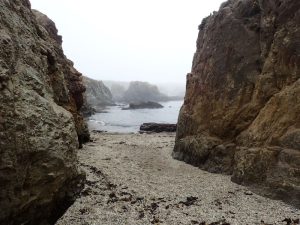
Getting to the Glass Beach Sites
Fort Bragg can be reached by either the Shoreline Highway, also known as Highway 1, or the Fort Bragg-Willits Road, also known as Highway 20. Both routes are narrow, twisty roads and are difficult to navigate with RVs or other large vehicles.
Site 1 was inaccessible for many years, but now reportedly can be accessed via the Noyo Point Road Trail, which opened around 2015. The Noyo Point Road Trail is a paved path that is also used by bikers. All the sites are accessible to the public, based on current information, and can be reached by trails from the parking area to the beach. However, access can still be closed at any time by State and City Park managers.
Since Glass Beach 3 is within the State Park, collecting of the glass is not allowed. Collecting is reportedly allowed but still discouraged at Glass Beach 1 and 2. The park jurisdictions end at the mean high-water mark, meaning you should be able to collect beach glass below this mark, but this is not marked at any of the sites. Low tides also offer the best opportunities for finding sea glass.
The parking area for all the sites is on the southwest corner of Elm Street and Noyo Point Road. It is easiest to start your visit at Site 3, and this is reached by walking west from the parking area and following a trail that forks to the right from the Noyo Point Road Trail. This fork goes northwest to the cliffs and beaches of Site 3. Site 2, based on descriptions online, is located about 300 feet south of Site 3 and is outside MacKerricher State Park. The park boundaries are not well-defined at the site. You can walk on the Noyo Point Road Trail to reach Site 2, but you will have to navigate a way down to the beach.
I could not find a map online that definitively shows the location of site 1. Based on descriptions and a 1920 USGS topographic map for Fort Bragg, a road extended from what is now West Fir Street to the coast. This is consistent with descriptions of a road that led to the dump from the middle of Fort Bragg. Site 1 can reportedly be reached from the Nolo Point Road Trail and finding a path to reach the beach. I have not been to Site 1, so I cannot confirm the location or status of any paths to the beach.
The following are GPS coordinates from Google Maps:
- Parking area for all Sites: 39°27’06.8”N 123°48’37.1” W
- Site 1, estimated location based on descriptions: 39°26’54.6”N 123°48’50.2” W
- Site 2, estimated location based on descriptions: 39°27’05.9”N 123°48’47.2” W
- Site 3, labeled on Google Maps as “Glass Beach”: 39°27’09.4”N 123°48’48.6” W
If you collect any sea glass, make sure you stay below the high-water mark, and remember that the sea glass is not being replenished. For now, these beaches have abundant sea glass, but it is a finite resource.

Other Glass Beaches
Sea glass and beach glass are found worldwide, as people routinely dumped glass-containing trash into seas, lakes, and rivers until relatively recently. Here are additional sites that have sea or beach glass.
North Beach, Port Townsend, Washington: Ocean refuse dumping, which ended in late 1960s, is the source of the sea glass.
Alki Beach Park, Seattle, Washington: This park dates from the beginning of the 1900s, and the sea glass is from garbage dumped off Alki Point.
Davenport Beach, Davenport, California: Glass washed into the sea from flooding at a 1970s glass studio. The beach is difficult and dangerous to access and not recommended for casual collectors.
Kauai Sea Glass Beach, Eleele, Hawaii: The sea glass is from dumping by local industry. The beach is small and collecting is strongly discouraged by the locals. Spectacle Island, Boston: This is a public park with sea glass that dates to the late 1700s. While you can access the beach, park regulations prohibit collecting the glass.
Grant Park Beach, Milwaukee, Wisconsin: Garbage scows and cliffside dumps are the source of beach glass at this park on the shore of Lake Michigan.
Tolchester Beach, Maryland: Located on the eastern side of Chesapeake Bay, this was a popular resort that operated from 1877-1962. Resort management dumped garbage offshore and glass washes onto the beach.
Woodland Beach, Delaware: Located on the western side of Delaware Bay, this beach was a former resort from the late 1800s to early 1900s. Trash collectors dumped garbage off the coast and glass is best found during low tide.
If you go to any of these beaches, do your research so you know where to go, when the tides are lowest, and to understand potential limits and restrictions to collecting.
This story about Fort Bragg previously appeared in Rock & Gem magazine. Click here to subscribe. Story and photos by Robert Beard.


